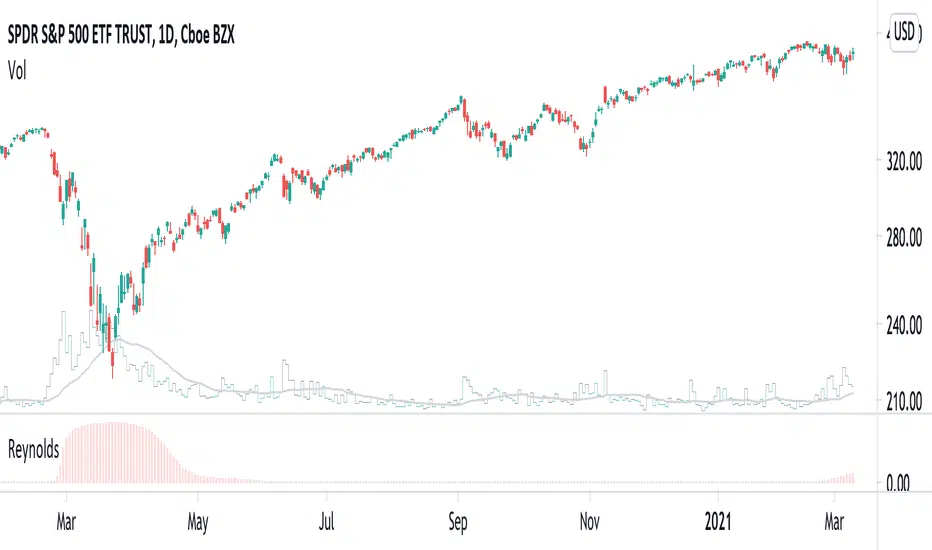OPEN-SOURCE SCRIPT
Reynolds warning rate

In fluid mechanics, the Reynolds number is the ratio of inertial forces to viscous forces within a fluid. Laminar flow occurs at low Reynolds numbers (i.e., viscous forces are dominant), whereas turbulent flow occurs at high Reynolds numbers (i.e., inertial forces are dominant). In the Turbulence indicator, I define that laminar flow occurs when simple moving averages have no interactions. In contrast, turbulent flow occurs when simple moving averages have chaotic interactions (i.e., irregular crossing and convergence).
Here, I calculate an economical analog of the Reynolds number developed by Jakimowicz and Juzwiszyn (2015). Furthermore, I propose the Reynolds Warning Rate, given by a ratio of short- and long-term Reynolds number.
The higher Reynolds Warning Rate indicates that price movement is going to a turbulence phase, and the market is under a possible systemic risk.
Reference:
Jakimowicz A, Juzwiszyn J (2015) Balance in the turbulent world of economy. Acta Physica Polonica A 127, 78–85.
Here, I calculate an economical analog of the Reynolds number developed by Jakimowicz and Juzwiszyn (2015). Furthermore, I propose the Reynolds Warning Rate, given by a ratio of short- and long-term Reynolds number.
The higher Reynolds Warning Rate indicates that price movement is going to a turbulence phase, and the market is under a possible systemic risk.
Reference:
Jakimowicz A, Juzwiszyn J (2015) Balance in the turbulent world of economy. Acta Physica Polonica A 127, 78–85.
Açık kaynak kodlu komut dosyası
Gerçek TradingView ruhuna uygun olarak, bu komut dosyasının oluşturucusu bunu açık kaynaklı hale getirmiştir, böylece yatırımcılar betiğin işlevselliğini inceleyip doğrulayabilir. Yazara saygı! Ücretsiz olarak kullanabilirsiniz, ancak kodu yeniden yayınlamanın Site Kurallarımıza tabi olduğunu unutmayın.
Feragatname
Bilgiler ve yayınlar, TradingView tarafından sağlanan veya onaylanan finansal, yatırım, işlem veya diğer türden tavsiye veya tavsiyeler anlamına gelmez ve teşkil etmez. Kullanım Şartları'nda daha fazlasını okuyun.
Açık kaynak kodlu komut dosyası
Gerçek TradingView ruhuna uygun olarak, bu komut dosyasının oluşturucusu bunu açık kaynaklı hale getirmiştir, böylece yatırımcılar betiğin işlevselliğini inceleyip doğrulayabilir. Yazara saygı! Ücretsiz olarak kullanabilirsiniz, ancak kodu yeniden yayınlamanın Site Kurallarımıza tabi olduğunu unutmayın.
Feragatname
Bilgiler ve yayınlar, TradingView tarafından sağlanan veya onaylanan finansal, yatırım, işlem veya diğer türden tavsiye veya tavsiyeler anlamına gelmez ve teşkil etmez. Kullanım Şartları'nda daha fazlasını okuyun.